Power Pitch
Quantitative Imaging & MR Fingerprinting
ISMRM & ISMRT Annual Meeting & Exhibition • 10-15 May 2025 • Honolulu, Hawai'i

| 15:45 |
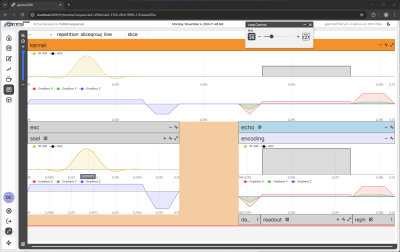 |
Screen Number: 26
1090. Modular
pulse sequence design in gammaSTAR: Intuitive Development with
instant Feedback and Simulations
A. Neisser, V. Kuhlen, S. Konstandin, M. Günther, D.
Hoinkiss
Fraunhofer Institute for Digital Medicine MEVIS, Bremen, Germany
Impact: By providing barrier-free access to pulse
sequence development, our environment enhances creativity
and collaboration in the research community. It encourages
novel sequence ideas and broadens MRI applications by
shifting the viewpoint on sequences from traditional to more
creative approaches.
|
| 15:49 |
 |
Screen Number: 27
1091. Reproducibility
of advanced MR measures across all 3 major scanner vendors in a
longitudinal 5-site multiple sclerosis study
I. Vavasour, A. Traboulsee, J. Oh, R. Tam, S. Kolind
University of British Columbia, Vancouver, Canada
Impact: CanProCo is a Canada-wide study collecting
advanced brain and spinal cord MRI. Reproducibility of
healthy control data was assessed to enable interpretation
of longitudinal multi-site multiple sclerosis data.
Variability in most MR metrics over 1 year was similar
between sites.
|
| 15:51 |
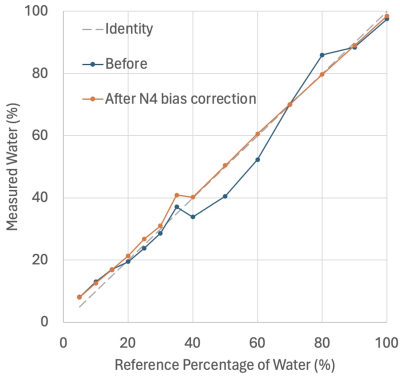 |
Screen Number: 28
1092. Quantifying
Free Water Content with the Look-Locker Method in MRI
J. Guo, C. Ying, B. Dogan, I. Pedrosa
UT Southwestern Medical Center, Dallas, United States
Impact: This study demonstrates a highly accurate,
optimized method for quantifying water fraction using the
Look-Locker sequence (qWaLL), improving artifact removal and
signal homogeneity. It offers significant potential for
enhancing diagnostic precision in tumor tissue
characterization and clinical applications.
|
| 15:59 |
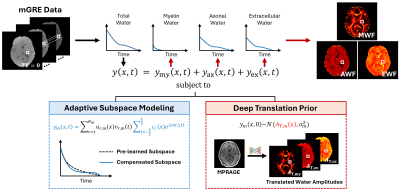 |
Screen Number: 29
1093. Improved
Myelin/Axonal/Extracellular Water Separation Using Adaptive
Probabilistic Subspaces and T1W-Translated Spatial Priors
R. Liu, Y. Li, Y. Guan, Z. Ke, S. Feng, W. Tang, Y. Li, Y.
Du, Z-P Liang
Beckman Institute for Advanced Science and Technology, University of Illinois at Urbana-Champaign, Urbana, United States
Impact: This method may improve the practical utility of
myelin/axonal/extracellular water fraction mapping. The
integration of deep translation priors and adaptive spectral
priors provides a promising framework for solving other
ill-conditioned inverse problems.
|
| 16:21 |
 |
Screen Number: 30
1094. Accelerated
and Accurate Myocardial T1 Mapping with PENGUIN: Combining Deep
Learning with Extended Phase Graph Modeling
C. Carvalho, A. Gaspar, R. Nunes, T. Correia
Instituto Superior Técnico, Universidade de Lisboa, Lisbon, Portugal
Impact: We propose a novel physics-based deep learning
method that performs accelerated myocardial $$$T_1$$$
mapping directly from undersampled k-space acquisitions
considering the Extended Phase Graph formulation, greatly
improving the accuracy of the estimated $$$T_1$$$ values
while shortening acquisition/reconstruction times.
|
| 16:15 |
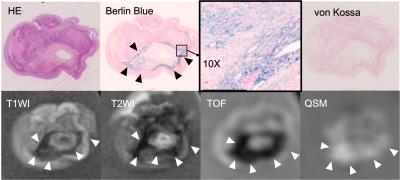 |
Screen Number: 31
1095. QSM
can distinguish hemosiderin from calcification in carotid
atherosclerotic plaque: an ex vivo MRI study of carotid
endarterectomy specimens
H. Ishimaru, A. Ishiyama, S. Okano, M. Morikawa, T. Nakano,
C. Somagawa, Y. Tasaki, S. Miyazaki, R. Toya
Nagasaki University Graduate School of Biomedical Sciences, Nagasaki, Japan
Impact: By using QSM, we can avoid misdiagnosing
hemosiderin in atherosclerotic plaque as calcification.
|
| 16:07 |
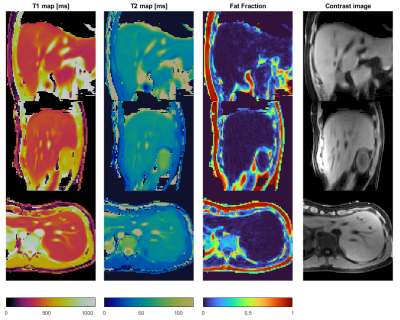 |
Screen Number: 32
1096. Highly-efficient
simultaneous 3D radial joint T1-T2-FF mapping for isotropic
resolution liver imaging at 0.55T
N. Garrido, C. Castillo-Passi, K. Kunze, C. Prieto, R.
Botnar
iHEALTH Millenium Institute, Santiago, Chile
Impact: Highly-efficient 3D radial joint T1-T2 and FF
mapping of the liver using low-field MRI could provide a
more affordable, accessible, and comprehensive approach for
liver disease assessment.
|
| 16:11 |
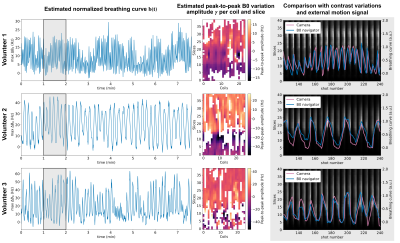 |
Screen Number: 33
1097. B0
navigator enables respiratory motion navigation in radial
stack-of-stars liver T1 mapping
J. Stelter, K. Weiss, V. Spieker, J. Schnabel, D. Karampinos
Technical University of Munich, Munich, Germany
Impact: B0 self-navigation allows to estimate
respiratory motion in acquisitions with varying contrasts
and quantifies the amplitude of B0 variations, enabling
self-gated reconstruction without external motion sensors.
This may be useful to develop patient-specific motion
correction in future studies.
|
| 16:01 |
 |
Screen Number: 34
1098. Comparison
of quantitative T1 and T2 brain imaging using 3D MR
Fingerprinting at 0.55T, 3T, and 7T
Z. Wang, C. Liao, Y. Yang, X. Cao
University of Arkansas for Medical Sciences, Little Rock, United States
Impact: This preliminary study highlights the robustness
of the novel 3D SPI-MRF with optimized protocols various
field strengths and presents a potential direction for
developing a general model to map quantitative data across
field strengths for broader healthcare applications.
|
| 16:05 |
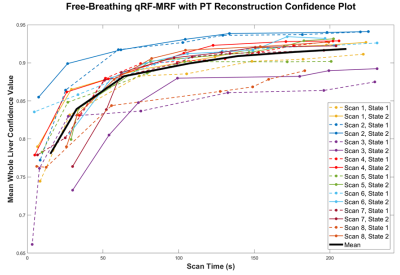 |
Screen Number: 35
1099. Reconstruction
Fidelity of Free-Breathing Magnetic Resonance Fingerprinting
(MRF) Reconstructions for Scan Time Reductions
M. Kretzler, J. Sun, C. Flask, M. Griswold, R. Boyacioglu
Case Western Reserve University, Cleveland, United States
Impact: Reducing acquisition and exam time is important
for patient comfort and adoption of MRF into clinical
workflows. We reduce required MRF with PT scan times in the
abdomen while maintaining quantitative tissue
characterization fidelity, laying groundwork for better
adaptive acquisitions.
|
| 16:03 |
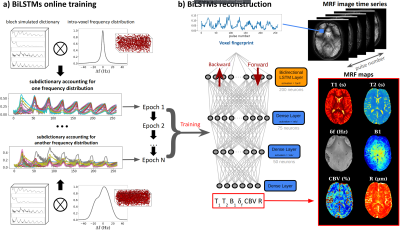 |
Screen Number: 36
1100. MARVEL
MRF for Contrast-free Blood Volume, Microvascular Properties,
and Relaxometry Mapping: Initial Tests in Volunteers and Stroke
Patients
A. Barrier, L. Cunge, T. Coudert, A. Delphin, L. Legris, G.
Oudoumanessah, L. Lamalle, F. Forbes, M. Doneva, B.
Lemasson, E. Barbier, T. Christen
Univ. Grenoble Alpes, Inserm, U1216, Grenoble Institut Neurosciences, GIN, Grenoble, France
Impact: MARVEL MRF produces high-quality relaxation maps
and non-contrast microvascular estimates in seconds from
high SNR acquisitions and an interesting robustness to
undersampling schemes. Once corrected for motion and shim
artifacts, MARVEL could be used for the management of stroke
patients.
|
| 16:19 |
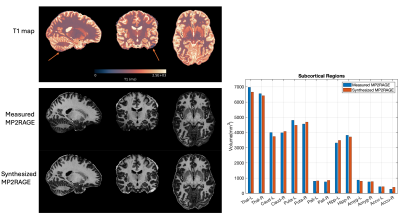 |
Screen Number: 37
1101. Synthetic
Image-Derived Phenotypes Using Physics-based Simulations:
Predicting Variability in Subcortical Volumes
H. Liu, N. Priovoulos, F. Lange, G. Bhalerao, S. Smith, K.
Miller, A. Hess
University of Oxford, Oxford, United Kingdom
Impact:
This pipeline is a first step in using image synthesis to generate matched IDPs precisely. It offers a foundation for exploring protocol sensitivity in neuroimaging biomarkers and can serve as a basis for addressing cross-protocol data harmonization challenges.
|
| 15:55 |
 |
Screen Number: 38
1102. Steady-State
sequences with spiral data acquisition for Multi-Slice CEST MRI
J. Hammacher, C. Kolbitsch, P. Schuenke
Physikalisch-Technische Bundesanstalt (PTB), Braunschweig and Berlin, Germany, Berlin, Germany
Impact: Here, we propose steady-state CEST sequences
with spiral readout to accelerate multi-slice CEST MRI while
maintaining high duty-cycles and image quality.
|
| 15:57 |
 |
Screen Number: 39
1103. Rapid
3D Whole-Brain High-Resolution T1 Quantification: Accelerating
Standard Inversion Recovery with Stack-of-Spirals FLASH
Acquisition
Z. Hu, D. Zhu, Q. Qin
Johns Hopkins University, Baltimore, United States
Impact: This
study demonstrates a 3D whole-brain 1mm-resolution IR-based
T1 mapping
method under 3.6min. The optimized IR technique was
accelerated using a 3D SoS-TFL readout with a short
presaturation time, a long echo train, as well as a large
undersampling factor.
|
| 15:47 |
 |
Screen Number: 40
1104. Vendor-Agnostic
Joint Relaxometry and Myelin Water Fraction Mapping with B1
Correction
S. Fujita, Y. Jun, A. Delattre-Klauser, G. Piredda, T.
Hilbert, C. Ariyurek, E. Milshteyn, Q. Liu, I. Shaik, Y.
Rathi, M. Zaitsev, J-F Nielsen, C. Jaimes, P. Grant, O.
Afacan, B. Gagoski, B. Bilgic
Athinoula A. Martinos Center for Biomedical Imaging Center, Boston, United States
Impact: A vendor-agnostic sequence for joint and rapid
acquisition of T1,
T2,
and myelin water fraction maps was proposed. Along with the
harmonized calibration scan, this package could be a
valuable tool for multi-site/multi-vendor neuroimaging
studies in adult and pediatric populations.
|
| 16:23 |
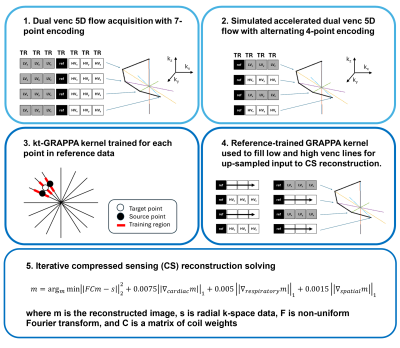 |
Screen Number: 41
1105. Flexible
kt-GRAPPA-initiated compressed sensing reconstruction approach
for accelerated dual-venc 5D flow imaging
T. Nallamothu, E. Weiss, J. Baraboo, J. Robinson, C. Rigsby,
C. Roy, M. Stuber, M. Markl
Northwestern Medicine, Chicago, United States
Impact: The proposed reconstruction method enables
accelerated dual-venc 5D flow with approximately 50%
reduction in scan time, increasing feasibility for a
clinical setting. Potential applications include detailed
analysis of cardiovascular hemodynamics over the respiratory
cycle in patients with congenital heart disease.
|
| 16:17 |
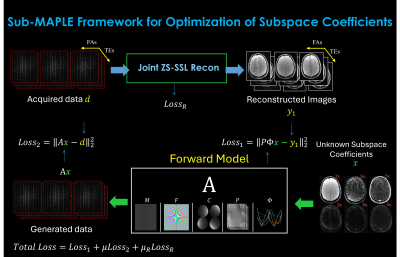 |
Screen Number: 42
1106. Accelerated
T1 and T*2 Mapping with Scan Specific Unsupervised Networks and
Subspace Modeling
A. Heydari, T. H. Kim, Y. Chen, A. Ahmadi, B. Bilgic
Amirkabir University of Technology, Tehran, Iran (Islamic Republic of)
Impact: Sub-MAPLE estimates T1,
T*2,
frequency, and proton density at high acceleration rates,
outperforming the state-of-the-art Joint MAPLE and
conventional methods. It incorporates subspace modeling with
phase priors, enabling high accuracy mapping from 15-fold
accelerated acquisitions.
|
| 16:09 |
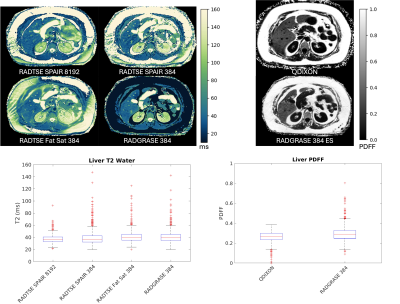 |
Screen Number: 43
1107. Respiratory
triggered abdominal T2-weighted imaging for concurrent T2water
mapping and PDFF quantification using RADGRASE
B. Toner, F. Han, S. Arberet, E. Ahanonu, K. Johnson, U.
Goerke, L. Jiang, S. Zhang, R. Akhbari, G. Block, D. Martin,
V. Deshpande, M. Nadar, A. Bilgin, M. Altbach
The University of Arizona, Tucson, United States
Impact:
Abdominal T2-weighted imaging, T2water, and PDFF quantification are important biomarkers for subjects with fatty liver disease. RADGRASE with respiratory triggering provided accurate measurements of these biomarkers through the whole abdomen in an accelerated (~ 3 min) free-breathing acquisition. |
| 16:25 |
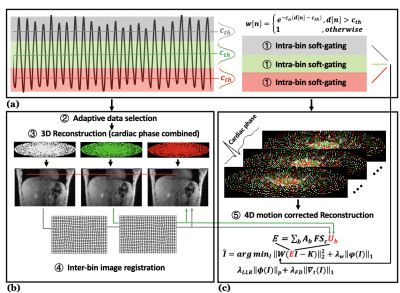 |
Screen Number: 44
1108. Adaptive
Free-Breathing Motion-Corrected 4D Flow of Liver at 5.0T
R. Cao, S. Li, A. Sun, H. Zhang, B. Wang, J. Hu, N. Yang, J.
Zhu, X. Zhang, J. Yuan, H. Li, H. Wang
Institute of Science and Technology for Brain-Inspired Intelligence, Fudan University, Shanghai, China
Impact: The proposed motion correction method improved
image quality and quantification accuracy, while reducing
scan times to a clinically acceptable 6–8 minutes.
|
| 15:53 |
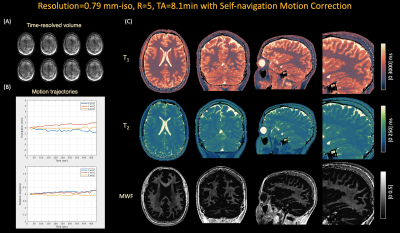 |
Screen Number: 45
1109. Mesoscale
Myelin Water Fraction Mapping at 3T with Self-navigated Motion
Correction
S. Fujita, Y. Jun, A. Delattre-Klauser, G. Piredda, T.
Hilbert, C. Ariyurek, O. Afacan, B. Gagoski, B. Bilgic
Athinoula A. Martinos Center for Biomedical Imaging Center, Boston, United States
Impact: We propose MWF-QALAS for simultaneous mapping of
T1,
T2,
and myelin water fraction (MWF) with self-navigated motion
correction for high-fidelity multi-parametric mapping on a
3T system at the mesoscale resolution of 790 um isotropic
within 8.1 minutes.
|
| 16:27 |
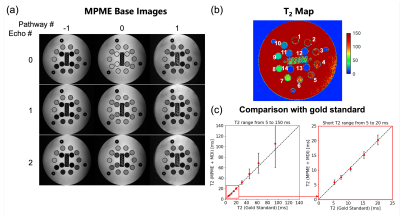 |
Screen Number: 46
1110. Application
of Multi-Echo SSFP Sequences Using Multiple Pathways on Short T2
Mapping
Y. Dong, P. Polak, Z. Zhong, C. Zhao, J. Hu, B. Li, F. Fang,
Y. Ye
University of Washington, Seattle, United States
Impact: Integrating MPME with MDI significantly improves
its T2 mapping accuracy and precision, especially in the
short T2 range, inspiring novel clinical applications that
require high-speed 3D T2 mapping techniques.
|
| 16:31 |
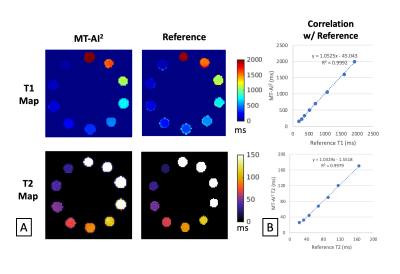 |
Screen Number: 47
1111. MR
Multitasking-driven Abdominal Integrated Imaging (MT-AI2)
J. Chen, Q. Kong, Y. Chen, D. Ling, E. Chang, A.
Christodoulou, D. Li, W. Yang, Z. Fan
University of Southern California, Los Angeles, United States
Impact: The MT-AI2 technique has the potential to
transform clinical abdominal MRI practices by enabling
faster, more efficient imaging. This advancement opens new
avenues for MR-guided radiation therapy planning and other
MR applications in the abdomin.
|
| 16:33 |
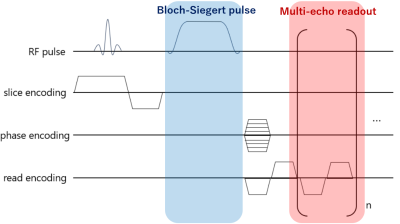 |
Screen Number: 48
1112. Multi-echo
Bloch–Siegert shift method for simultaneous B1 magnitude and
phase mapping
M. Fushimi, K. Ikemoto, S. Kusahata, M. Sekino
The University of Tokyo, Tokyo, Japan
Impact: The developed sequence accelerates complex B1
mapping by enabling simultaneous acquisition of the
magnitude and phase of the B1 field with equivalent accuracy
to conventional methods in which these images are obtained
separately, facilitating electrical property tomography.
|
| 16:29 |
 |
Screen Number: 49
1113. Self-Correction
of B0 Field Drift and k-space Trajectory Errors in Alternating
Unbalanced SSFP for Robust R2 and R2’ Mapping
E. Bae, S. Oh, F. Wehrli, H. Lee
Kyungpook National University, Daegu, Korea, Republic of
Impact: The proposed method, which mitigates artifacts
from B0 drift and trajectory mismatch in a self-correction
manner, may prove to be a useful means in a wide range of
neuroimaging studies seeking rapid and accurate
quantifications of R2 and R2’.
|
The International Society for Magnetic Resonance in Medicine is accredited by the Accreditation Council for Continuing Medical Education to provide continuing medical education for physicians.